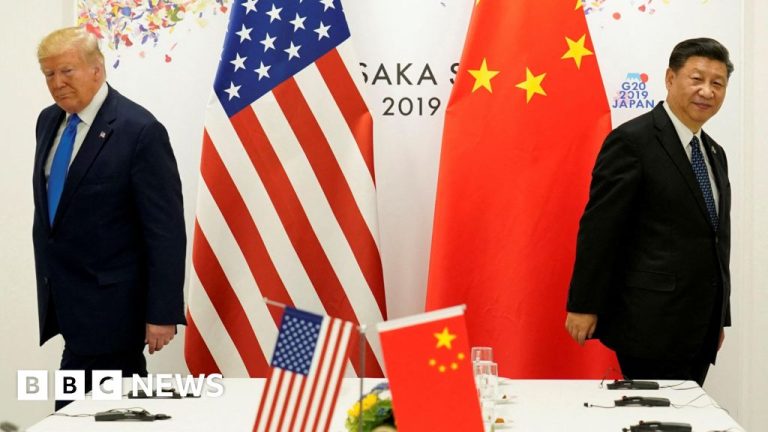Reuters
Donald Trump and Xi Jinping during their last face-to-face meeting in 2019
China is expected to unveil new measures to boost its flagging economy as it prepares for a second Donald Trump presidency.
Trump won the election on a platform that promised high import taxes, including tariffs of up to 60% on goods made in China.
His victory now risks hampering Xi Jinping's plans to transform the country into a technology powerhouse – and further straining relations between the world's two largest economies.
The real estate crisis, rising public debt and unemployment, as well as weak consumption have slowed Chinese growth since the pandemic.
The stakes are higher than ever following the latest announcement from the Standing Committee of the National People's Congress (NPC), the executive arm of China's legislature.
During his first term, Trump imposed tariffs of up to 25% on Chinese goods.
China analyst Bill Bishop says Trump should be taken at his word on his new tariff plans.
“I think we should believe that he is serious about tariffs, that he believes that China has reneged on its trade deal, that he thinks that China and Covid cost him the election of 2020”.
Pressure from Washington did not ease after Trump left the White House in 2021. The Biden administration kept the measures in place and, in some cases, expanded them.
While Trump's first wave of tariffs was painful for China, the country now finds itself in a much more vulnerable position.
The economy has struggled to return to pre-pandemic growth levels since strict Covid restrictions were abruptly lifted two years ago.
Instead of achieving a widely expected rapid recovery, China has become a regular source of disappointing economic news.
Even before Trump's election victory and after China began rolling out economic support measures in September, the International Monetary Fund (IMF) lowered its annual growth target for the country.
The IMF now expects China's economy to grow 4.8% in 2024, which is at the lower end of Beijing's target of around 5%. Next year, China's annual growth rate is expected to decline further to 4.5%.
But the country's leaders were not completely caught off guard by the end of decades of lightning-fast growth.
Speaking in 2017, President Xi said his country planned to move from “rapid growth to a high-quality development stage.”
The term has since been used repeatedly by Chinese officials to describe a transition to an economy driven by advanced manufacturing and green industries.
But some economists say China cannot simply export its way out of its difficulties.
China risks falling into the type of decades-long stagnation that Japan experienced after a stock and housing bubble burst in the 1990s, said Stephen Roach, former chairman of Morgan Stanley Asia.
To avoid this fate, he believes that China should rely “on untapped consumer demand” and move away from “growth driven by exports and investments”.
This would not only encourage more sustainable growth, but also reduce “trade tensions and (China's) vulnerability to external shocks”, he says.
This more robust economic model could help China fend off the kinds of threats posed by Trump's return to power.
New economy, old problems
But China, which has long been the world's factory for low-cost goods, is trying to replicate that success by exporting high-tech products.
It is already a global leader in solar panels, electric vehicles (EVs) and lithium-ion batteries.
According to the International Energy Agency (IEA), China now accounts for at least 80% of solar panel production. It is also the largest manufacturer of electric vehicles and the batteries that power them.
The IEA said last year that China's investments in clean energy accounted for a third of the global total, as the country continued to show “remarkable progress in adding renewable capacity.”
“There is certainly a global effort to support high-tech manufacturing in China,” says David Lubin, a senior fellow at the London-based think tank Chatham House.
“It was a great success,” he adds.
Exports of electric vehicles, lithium-ion batteries and solar panels jumped 30% in 2023, surpassing 1 trillion yuan ($139 billion; £108 billion) for the first time as China continued to strengthen its global dominance in each of these industries.
This growth in exports has helped soften the blow to the Chinese economy from the current real estate crisis.
“China’s overcapacity will increase, there is no doubt about it. They have no other source of growth,” said Alicia Garcia-Herrero, chief economist for the Asia-Pacific region at investment bank Natixis.
But alongside this increase in exports, there has been a rise in resistance from Western countries, not just the United States.
Last month, the European Union raised tariffs on electric vehicles made in China by up to 45%.
“The problem right now is that the big recipients of these goods, notably Europe and the United States, are increasingly reluctant to receive them,” said Katrina Ell, research director at Moody's Analytics.
Now, as Trump prepares to return to the Oval Office with a pledge to increase Chinese imports, Beijing will have to ask whether its latest moves to boost its slowing economy will be enough.

